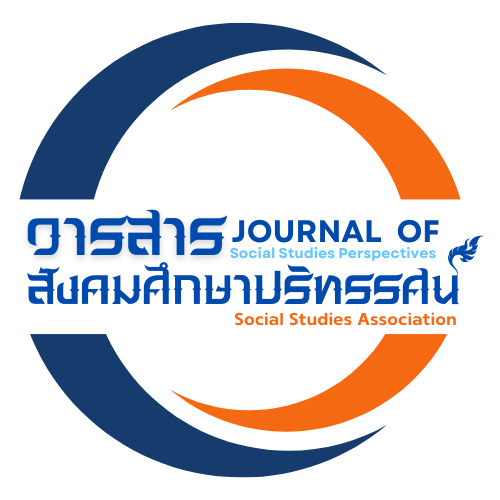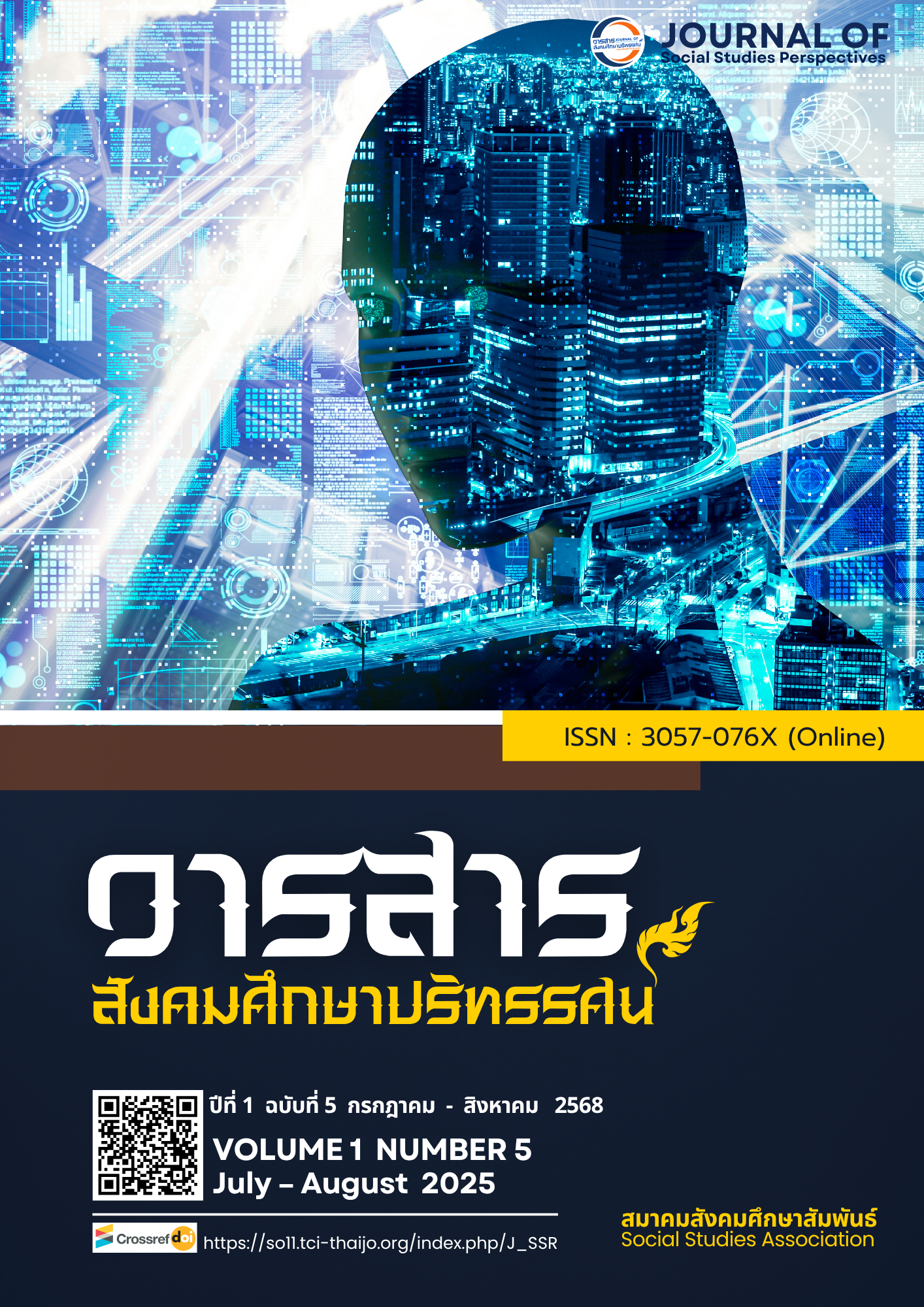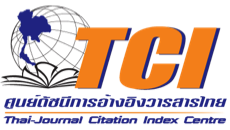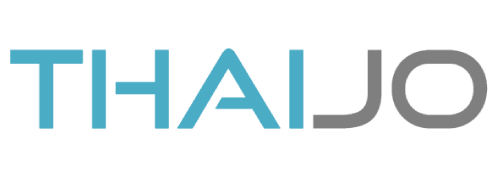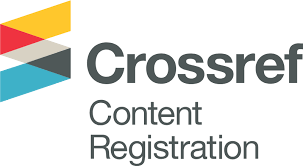การพัฒนาหลักสูตรฝึกอบรมการประยุกต์ใช้ปัญญาประดิษฐ์ในการจัดการเรียนรู้ของครู สังกัดเทศบาลนครนครศรีธรรมราช
DOI:
https://doi.org/10.64186/jsp1918%20%20คำสำคัญ:
หลักสูตรฝึกอบรม, การประยุกต์, ปัญญาประดิษฐ์, การจัดการเรียนรู้บทคัดย่อ
บทความวิจัยนี้มีวัตถุประสงค์ เพื่อพัฒนาหลักสูตรฝึกอบรมการประยุกต์ใช้ปัญญาประดิษฐ์ในการจัดการเรียนรู้ของครู สังกัดเทศบาลนครนครศรีธรรมราช ได้ศึกษาระเบียบวิธีการวิจัยการพัฒนาหลักสูตรตามแนวคิดของ Saylor and Alexander (1974) ร่วมกับแนวคิดกระบวนการวิจัยและพัฒนา (Research and Development) ประกอบด้วย 4 ขั้นตอน ได้แก่ ขั้นตอนที่ 1 การศึกษาและวิเคราะห์ข้อมูลพื้นฐาน ขั้นตอนที่ 2 การออกแบบและพัฒนาหลักสูตร ขั้นตอนที่ 3 การทดลองใช้หลักสูตร และ ขั้นตอนที่ 4 การประเมินผลและปรับปรุงหลักสูตร เป็นกรอบการวิจัย กลุ่มตัวอย่างที่ใช้ในการวิจัยครั้งนี้มี 5 กลุ่ม ได้แก่ กลุ่มที่ 1 เป็นครูที่ปฏิบัติการสอน สังกัดเทศบาลนครนครศรีธรรมราช จำนวน 364 คน และ กลุ่มผู้ให้ข้อมูลสําคัญจากการสัมภาษณ์ จํานวน 16 คน กลุ่มที่ 2 เป็นครูที่ปฏิบัติการสอน สังกัดเทศบาลนครนครศรีธรรมราช ที่สมัครใจเข้ารับการฝึกอบรม จำนวน 30 คน กลุ่มที่ 3 เป็นกลุ่มตัวอย่างที่ใช้ในการทดลองใช้หลักสูตร เป็นครูที่ปฏิบัติหน้าที่โรงเรียนเทศบาลวัดศาลามีชัย อำเภอเมือง จังหวัดนครศรีธรรมราช จํานวน 30 คน และกลุ่มที่ 4 เป็นครูที่ผ่านการฝึกอบรมในขั้นตอนการทดลองใช้หลักสูตรฝึกอบรม จํานวน 2 คน และ กลุ่มที่ 5 คือ นักเรียนชั้นประถมศึกษาชั้นปีที่ 6/1 จํานวน 33 คน เครื่องมือที่ใช้ในการวิจัย ได้แก่ 1) แบบสอบถามเกี่ยวกับสภาพปัจจุบันและสภาพที่พึงประสงค์ 2) สัมภาษณ์กึ่งมีโครงสร้าง 3) แบบประเมินการฝึกปฏิบัติ 4) แบบทดสอบ 5) แบบประเมินความเหมาะสมของโครงร่างลักสูตร 6) แบบประเมินความเหมาะสมของหลักสูตร 7) แบบประเมินความสอดคล้องของหลักสูตร และ 8) แบบสังเกตพฤติกรรม สถิติที่ใช้ในการวิเคราะห์ข้อมูลได้แก่ ร้อยละ ค่าเฉลี่ย ค่าเบี่ยงเบนมาตรฐาน และค่าที ผลการวิจัยพบว่า
- ด้านการใช้เทคโนโลยีสารสนเทศสารสนเทศและการสื่อสาร มีความต้องการจำเป็นมากที่สุด (ค่า PNI = 0.092) รองลงมา คือ ด้านการจัดการชั้นเรียน (ค่า PNI = 0.089) ด้านการการออกแบบการจัดการเรียนรู้ (ค่า PNI = 0.086) และ การวัดปละประเมินผลการเรียนรู้ (ค่า PNI = 0.084) จากการพิจารณาความต้องการจำเป็นโดยใช้ค่า PNI Modified พบว่าทั้ง 4 ด้านมีค่าเกินร้อยละ 5 (PNI > 0.05) ซึ่งเป็นค่าที่อยู่ในระดับยอมรับได้ สำหรับนำข้อมูลไปใช้ในการพัฒนาหลักสูตรฝึกอบรมในละดับต่อไป
- ผลการออกแบบและพัฒนาหลักสูตร พบว่า การศึกษาและวิเคราะห์ข้อมูลพื้นฐานช่วยให้สามารถออกแบบและเขียนโครงร่างหลักสูตรภายใต้รูปแบบการประยุกต์ใช้ปัญญาประดิษฐ์ในการจัดการเรียนรู้ของครู โดยสามารถกําหนดเนื้อหา กิจกรรม สื่อและการประเมินผลได้สอดคล้องกับความต้องการและสภาพการนําไปใช้ในชั้นเรียนได้จริง ส่งผลให้องค์ประกอบของโครงร่างหลักสูตรมีความเหมาะสมและสอดคล้องกันทุกองค์ประกอบ
- ผลการทดลองใช้หลักสูตร พบว่า หลักสูตรมีประสิทธิภาพ มีค่าเท่ากับ 24/85.55 อีกทั้งยังพบว่า ผู้เข้าอบรมมีความรู้และความเข้าใจเกี่ยวกับการประยุกต์ใช้ปัญญาประดิษฐ์ในการจัดการเรียนรู้หลังฝึกอบรมสูงกว่าก่อนฝึกอบรมอย่างมีนัยสําคัญทางสถิตที่ระดับ 0.05
- ผลการประเมินผลและปรับปรุงหลักสูตร พบว่า หลักสูตรมีความเหมาะสมและสอดคล้องกันทุกองค์ประกอบ และมีประสิทธิภาพตามเกณฑ์ที่กําหนดไว้
เอกสารอ้างอิง
Ahmad, S. F., Alam, M. M., Rahmat, M. K., Mubarik, M. S., & Hyder, S. I. (2022). Academic and
administrative role of artificial intelligence in education. Sustainability, 14(3).
Creswell, J. W., & Plano Clark, V. L. (2011). Designing and conducting mixed research (2nd
ed.). Sage.
Cronbach, L. J. (1990). Essentials of psychological testing (5th ed.). Harper Collins.
Firuz Kamalov, D., Santandreu Calonge, D., & Gurrib, I. (2023). New era of artificial intelligence
in education: Towards a sustainable multifaceted revolution. Sustainability, 15(16).
Funchian, N. (2025, February 7). How about 4.0 era teaching? https://bit.ly/3qxAODe
Ge, Z., & Hu, Y. (2020). Innovative application of artificial intelligence (AI) in the management
of higher education and teaching. Journal of Physics: Conference Series, 1533(3),
Kaemkate, W. (2008). Behavioral research methodology (2nd ed.). Chulalongkorn University
Printing House.
Kanjanawasee, S. (2002). Evaluation theory (3rd ed.). Chulalongkorn University Press.
Khosravi, H., Sadiq, S., & Amer-Yahia, S. (2023). Data management of AI-powered education
technologies: Challenges and opportunities. Learning Letters, 1, 2.
Kirkpatrick, D. L. (1998). Evaluating training programs: The four levels (2nd ed.). Berrett-
Koehler Publishers.
Kitcharoen, J. (2022). Curriculum development, competency enhancement course, integrated
learning management, community context and local culture, preservice students
(Doctoral dissertation, Curriculum and Instruction Department, Silpakorn University).
Krejcie, R. V., & Morgan, D. W. (1970). Determining sample size for research activities.
Educational and Psychological Measurement, 30(3), 607–610. https://doi.org/xxxxxx
Likert, R. (1967). The method of constructing and attitude scale. In Attitude theory and
measurement (pp. 159–202). Wiley & Sons.
Munjit, C. (2023). Local learning strand curriculum development on the topic of Pan Sip
Plasalid in the career learning strand group for Mathayomsuksa 2 students. National
Conference on Applied Research 5th “New Dimensions of the World after the COVID-
Pandemic: Challenges and Opportunities.” North Bangkok University.
Nakhon Si Thammarat Municipality. (2025, January 22). Government administration.
https://www.nakhoncity.org/education.php
Office of the Education Council. (2020). Educational reform proposals in the second decade
(2009–2018). Prik Wan Graphic Co., Ltd.
Onkasem, P., Nithichaiyo, S., Insumpao, Y., & Ploysri, K. (2022). Educational innovation
development for enhancing of new normal-based teaching efficiency during the
COVID-19 pandemic of schools in Don Chimplee Subdistrict, Bang Nam Priao District,
and Chachoengsao Province. National Academic Conference on Applied Research
“Innovation Changes the World.” North Bangkok University.
Phimonsangsuriya, A. (n.d.). 10 disruptive technology trends that affect lifestyle.
ThansettakijOnline. https://bit.ly/3FAsHwa
Phonesay, L. (2025). Development of enrichment curriculum to enhance digital intelligence
of students at Savannakhet University, Lao People’s Democratic Republic (Doctor of
Philosophy, Research of Curriculum and Instruction, Sakon Nakhon Rajabhat
University).
Promwong, C. (1983). Teaching documents for educational technology and communication.
Sukhothai Thammathirat Open University.
Saylor, J. G., & Alexander, W. M. (1974). Planning curriculum for schools. Holt, Rinehart &
Winston.
Srisa-ard, B. (2017). Preliminary research (10th ed.). Suwiriyasan.
Tharmawitigul, A. (2009). Internal supervision process. Aksorn Service.
Wongwanich, S. (2007). Needs assessment research. Chulalongkorn University Press.
ดาวน์โหลด
เผยแพร่แล้ว
รูปแบบการอ้างอิง
ฉบับ
ประเภทบทความ
หมวดหมู่
สัญญาอนุญาต
ลิขสิทธิ์ (c) 2025 วารสารสังคมศึกษาปริทรรศน์

อนุญาตภายใต้เงื่อนไข Creative Commons Attribution-NonCommercial-NoDerivatives 4.0 International License.
บทความนี้ได้รับการเผยแพร่ภายใต้สัญญาอนุญาต Creative Commons Attribution-NonCommercial-NoDerivatives 4.0 International (CC BY-NC-ND 4.0) ซึ่งอนุญาตให้ผู้อื่นสามารถแชร์บทความได้โดยให้เครดิตผู้เขียนและห้ามนำไปใช้เพื่อการค้าหรือดัดแปลง หากต้องการใช้งานซ้ำในลักษณะอื่น ๆ หรือการเผยแพร่ซ้ำ จำเป็นต้องได้รับอนุญาตจากวารสาร
